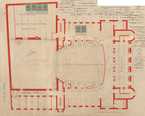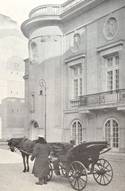Arnold Szyfman Polski Theatre
alias Theatre der Stadt Warsau (Warsaw City Theatre, 1940-1945), Teatr Polski (The Polski Theatre, 1913-1940)ul. Karasia 2 | |
| show on the map | http://www.teatr-polski.art.pl/ |
Important events
People
History
The Polski Theatre in Warsaw, designed by Czesław Przybylski, was opened in 1913. The representative building with its elegant foyer and cloakrooms, an auditorium for 1000 spectators, a modern revolving stage with a mechanical fly system and a cyclorama, was erected and equipped within only nine months. It is one of the few buildings in Warsaw not destroyed during the Second World War. As a result, it is the only theatre from the beginning of the 20th century in the capital preserved in its original beautiful shape. Sculpture decorations, including five medallions depicting characters of Polish plays, are the work of Zygmunt Otto. The public rooms, the backstage area and the orchestra pit are all open to visitors.
Teatr Polski im. Arnolda Szyfmana w Warszawie
Karasia 2 · 00-327 Warsaw · Poland · tel. +48 22 826 49 18
E-Mail: rezerwacje@teatrpolski.waw.pl · www.teatrpolski.waw.pl
Visits: by appoitment.
The early modernist edifice of the Polski Theatre in Warsaw was the first modern theatre erected in Poland in the 20th century. The designer was Czesław Przybylski, an architect from the first generation of modernists. The theatre, located behind tenement houses on Krakowskie Przedmieście street, was not to be seen from a long perspective. The unfortunate location imposed solutions that allowed the architecture of the theatre to arise in the city space. The elegant edifice, though not large, is an example of early modernist neoclassical style with reference to the French empire style that was typical of European architecture erected about 1912 (in remembrance of Napoleon’s march towards Moscow). The three-storey edifice, with its gentle design, semicircular projections and French windows, light colour scheme (cream plastering) and subtle sculpture decorations (five bas-relief medallions by Zygmunt Otto, depicting characters from Polish dramas) gave an indication of the splendid interior which charmed contemporaries with its “palatial” elegance, its “charm and grace“, the light colour scheme and spaciousness, visually multiplied through the use of mirrors.
Connecting ideas of Baroque provenance with antiquity, the edifice introduced new modernist elements into theatre architecture: a new idea for the cloakroom and the way of treating the vast open space on the ground floor with a corridor arched around the stalls. White marble stairs led to the polygonal foyer, which from an architectural point of view was regarded as the noblest recess of the edifice. Breaking with the traditional redness of 19th century theatre interiors, the decorations of the Polish Theatre were given a modernistic colour scheme: blue and white with discreet gildings and new-empire interior decorations and furnishing (Louis XVI and empire marquetry furniture, covered with goldish “brocade” in the stalls and in the boxes, seats upholstered in grey, a pearl grey curtain, frescos, and mirrors). The exquisite decorations were completed by subtle paintings by Edward Trojanowski. Although the house, holding 1004 spectators, was of the 19th century type, the construction of the ceiling (reinforced concrete), supported on two columns, passing into pilasters on balconies, was the most modern at that time.
As far as the technical equipment is concerned, the theatre was a revelation. The stage had an area of 400 square metres (20.55 metre-wide, 19.80 metre-deep and 18.50 metre-high) and contained the first and the most modern revolving stage in Poland (17 metres in diameter), which is still in use. The semicircular backdrop, giving pictorial effects, was a novelty, as was the electric lighting of the newest type (Schwabe lamp of 60,000 candles installed in forty arc lamps) and the shape of the prompter’s box: an almost invisible box replacing a traditional shell. The theatre had modern, spacious infrastructure.
Opened in 1913, the Polski Theatre gave performances without interruption until 1939. After capturing Warsaw, the Germans opened the Theater der Stadt Warschau in the building. Although they destroyed the city after the Warsaw Uprising in 1944, they spared the theatre: part of the decorations and the revolving stage were preserved. Renovated under the direction of Konstanty Jakomowicz, with four decorative panels by Tadeusz Gronowski, the theatre was reopened in 1946. In 1982, the modernist colour scheme of the interior was changed: the grey of the upholstery and of the curtain was replaced with the more traditional “theatrical” redness. As a result, the subtle elegance of the early-modernist space was lost.
The building of the Polski Theatre, was a forerunner of the modernist, rationalist “Warsaw school” of Polish architecture, and represents one of the most outstanding works of 20th century architecture in Poland.
Literature:
1. „Architekt” 1913, no. 3-4.
2. "Architektura i Budownictwo" 1936, No. 8-9-10.
3. Artyści Teatru Polskiego w Warszawie, katalog, Wydawnictwo Centralnego Biura Wystaw Artystycznych, Warszawa 1988.
4. Dienstl M., Gmach nowego Teatru Polskiego [w:] „Kurier Warszawski” 1913, No. 28.
5. Iwaszkiewicz J., Teatr Polski w Warszawie 1938-1949, Wydawnictwa Artystyczne i Filmowe, Warszawa 1983.
6. Krasiński E., Teatr Polski Arnolda Szyfmana 1913-1939, Wydawnictwo Naukowe PWN, Warszawa 1991.
7. Krasiński E., Teatr Polski w Warszawie 1939-2002, Wydawnictwo Teatru Polskiego w Warszawie, Warszawa 2002.
8. Król-Kaczorowska B., Teatr Polski. Dzieje budynku, Państwowe Wydawnictwo Naukowe, Warszawa 1988.
9. Lorentowicz J., Teatr Polski w Warszawie 1913-1938, Instytut Wydawniczy „Biblioteka Polska”, Warszawa 1938.
10. Martyka S., Odbudowa gmachu Teatru Polskiego w Warszawie [w:] „Teatr” 1947, No. 7/8.
11. Teatr Polski. Arnold Szyfman, Warszawa 1948.
12. Teatr Polski w Warszawie 1913-1923, Towarzystwo Wydawnicze „Ignis”, Warszawa 1923
13. Teatry Polskie w trzydziestoleciu 1944-1974. Słownik, Polska Akademia Nauk, Instytut Sztuki, Warszawa 1975.
14. W 70-lecie otwarcia Teatru. W 100 rocznicę urodzin jego twórcy, Teatr Polski w Warszawie, 1983.
15. "Tygodnik Ilustrowany" 1913, No. 5.
16. Warszawski Przewodnik Teatralny, Warszawa 1988.
Author: Marta Leśniakowska
Additional information
No information has yet been entered
Add information





















